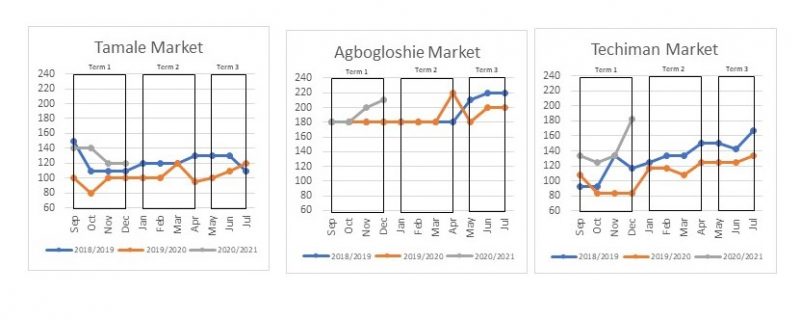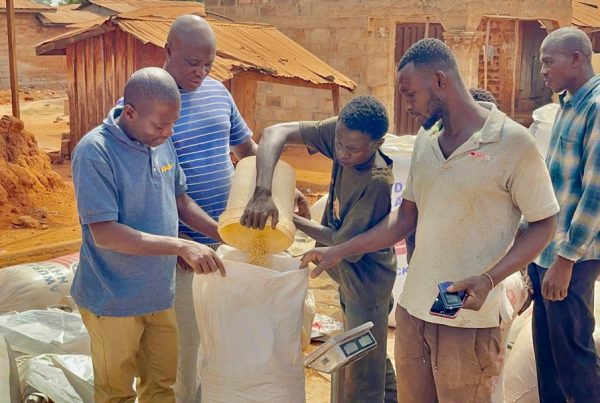Esoko looked at the prices of a 100kg bag of maize across Tamale, Techiman and Agbogbloshie markets in 2018, 2019, 2020. Maize is an important crop in Ghana, grown by most farmers and serves as a major source of agricultural income. It is in high demand by the poultry industry and for human consumption.
Since the President announced schools were to reopen in January, there has been some concern that a sudden rise in food demand from +700 schools could cause a spike in food prices – especially for staples like maize, gari etc. which make up a big proportion of school meals.
The following analysis uses the school calendar year (Sept – July) to explore (a) whether open market prices have been affected in the past by school term cycles and (b) with such short notice for schools to reopen, can we expect any impact on Maize? The price of maize is already on the rise. The question is not so much whether it will, but by how much it will increase.
General trend of maize prices since 2018
On average, the price for a 100kg bag of maize dropped from 2018/2019 to 2019/2020 across all 3 markets and then rose again in 2020/2021 above 2018/2019 levels. The table below shows year-on-year percentage increase/decrease in maize prices from 2018 – 2021:

Table 1: Year-on-year change in Maize prices (percentage) from 2018 – 2021
The success of the Planting for Food and Jobs initiative could explain the drop in prices from 2018 to 2019 – maize production improved under the subsidy program, increasing supply and pushing prices down. However, 2019/2020 came with external shocks and challenges to maize supply that have reversed some of these gains, these include:
- Flooding and the effects of climate change in the northern regions, where majority of Ghana’s maize is grown, caused major losses in maize production.
- Covid-19 and the lockdown led to lower incomes, fueled uncertainty and risk averseness to investing in maize production leading to lower production levels.
- Shortages in surrounding countries also encouraged some of Ghana’s maize to be sold outside the country.
Impact of school term cycle on maize prices
The National Food Buffer Stock company’s mandate is to provide schools with food supplies. As schools are not meant to purchase from the open market, we should not see any spike in maize prices. If however there is any shortage in the buffer stock, schools may be forced to go to the open market, which would intensify the competition with poultry and consumption and cause a sharp increase in prices.
Techiman and Tamale are major markets, while Agbobloshie is a consumer market. If there are any shortfalls in the buffer stock system we should expect to see these effects at Techiman and Tamale. This is because schools would prefer to purchase from major markets that sell higher volumes of maize at lower prices, than from consumer markets.
From the graphs below, there is no significant pattern or trend in the previous years showing maize price increasing before school terms start (an effect of increased demand) or price decreasing when term ends (an effect of decreased demand). In the absence of this direct effect, it is fair to conclude that in the period under review, schools did little or no direct buying from the open market. This implies the buffer stock company fulfilled its mandate to supply schools with food and keep prices stable on the open market.

Figure1: Average price of 100kg bag of maize across school term calendar
What to expect for January 2021
With such short notice for schools to reopen, how markets respond will be telling on the preparedness of the buffer stock system. The last quarter of 2020 ended with maize prices rising in Techiman and Agbogbloshie. It is expected that this trend will continue in January due to persistence of the challenges mentioned earlier.
During the period examined, the largest increase in month-on-month average price was GHS 50 in Techiman; GHS 40 in Agbogbloshie and GHS 20 in Tamale. Thus, all things being equal we can expect any further rise in average prices from December 2020 to January 2021 to be within these boundaries in the respective markets. Any sizeable deviation away from this trend could signal school demand spillovers unto the open market.


